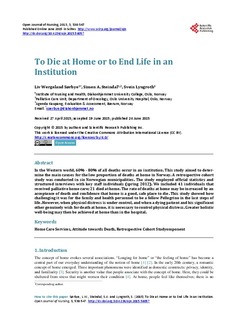| dc.description.abstract | In the Western world, 60% - 80% of all deaths occur in an institution. This study aimed to determine the main causes for the low proportion of deaths at home in Norway. A retrospective cohort study was conducted in six Norwegian municipalities. The study employed official statistics and structured interviews with key staff individuals (spring 2012). We included 41 individuals that received palliative home care; 21 died at home. The rate of deaths at home may be increased by an acceptance of death and confidence that home is a good, safe place to die. This study showed how challenging it was for the family and health personnel to be a fellow Pellegrino in the last steps of life. However, when physical distress is under control, and when a dying patient and his significant other genuinely wish for death at home, it is necessary to control physical distress. Greater holistic well-being may then be achieved at home than in the hospital. | nb_NO |
